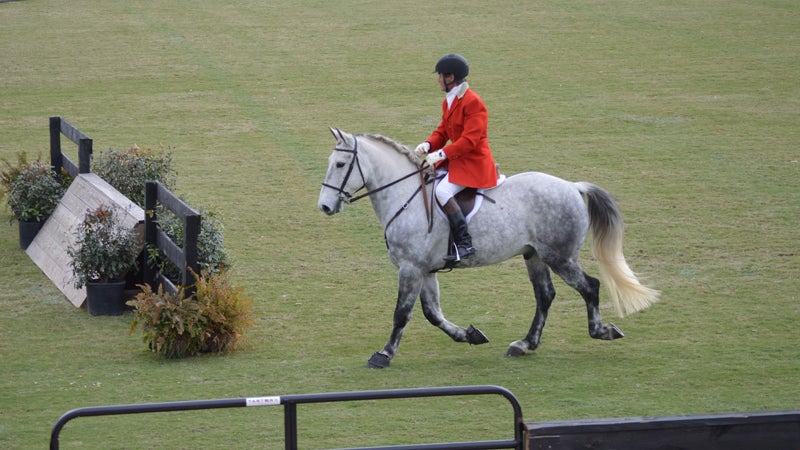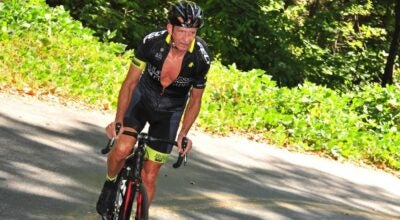Conditions of conditioning – Tips for spring conditioning
Published 11:26 am Tuesday, February 13, 2018

- Walking interspersed with short intervals of trotting is an excellent way to begin conditioning a horse that is put back into work in the spring. (photo by Catherine Hunter)
Spring is just around the corner — the crickets and bullfrogs are starting to sing and the warm weather is coming.
If it ever stops raining long enough to ride, Foothills horse lovers will again be enjoying the trails after this exceptionally cold winter.
While we are all shaking off a little cabin fever, it is important to consider the horse’s condition if they have been off from work through the winter. Asking a horse to go on a long or fast ride when they are not in shape can not only damage the horse’s heart, wind, tendons, joints and muscles, it can betray the animal’s trust, and make them fear being ridden again.
Walking and trotting is the best place to start a fitness program. Rides in the beginning of the conditioning program should be kept short, approximately 20 to 30 minutes, and can gradually increase as the horse gains stamina.
In the beginning of the program, the rider should limit the number of days per week the horse is ridden. If the horse has done nothing but loaf in the field since early November, a five-day per week program will be too much to start. Consider riding one or two days, and then giving the horse a day or two off. If the rider wants to ride more often, she can gradually build up to five or more days a week.
It is also important to consider the terrain used for conditioning.
Fairly flat ground is a good place to begin. The rider can add hill work starting with a few low hills, and build gradually. Limit hill work to every third ride or so, in order not to make the horse’s muscles sore.
The horse should not be allowed to loaf through his gaits at a slow walk or jog. A forward medium walk with good impulsion is best. The rider must be careful not to push the horse into an extended walk.
If the horse has not been ridden for many months or is elderly, the rider should consider staying in the walk for the first few rides. After the first ride or two, the rider can begin adding short trots for three to five minutes and gradually increase the trot time.
Trots should be limited to once or twice per ride for the first few rides.
A good rule is to increase the speed of the gait for short intervals, and vary that with increasing the length of the ride on other days. The rider can pause after a few minutes of trotting and observe the horse’s nostrils and flanks for increased breathing. If the horse’s breathing does not return to normal in a few moments, then the rider can reduce the length of trotting time until the horse’s wind is stronger.
Another good guide is to take the horse’s pulse and respiration before and after the ride. The pulse and respiration should return to normal within 15 minutes or so after working.
Also check to see how fast the horse cools down while being walked out after the ride. Quick recovery of pulse, wind and body temperature are good indicators the horse is responding well to conditioning.
Riding on a loose or long rein is also a good way to allow the horse to relax and stretch his muscles. Asking the horse to go on the bit or trying for collection before the horse has the muscles to respond correctly can do much damage not only to his body, but also his heart and mind.
While supplling work is a good addition to a conditioning routine, the rider must again be cautious of asking for too much, too soon. A good place to start is with big circle and turns, and adding a few strides at the extended walk and extended trot a couple of times every third ride.
Leave the leg yields, small circles and flexions until the horse has developed the muscles to respond in a relaxed, balanced manner.
Of course, any conditioning routine should be customized for the individual horse. Older horses will take longer to regain their condition than young horses, and thoroughbreds will often hold their condition longer than cold bloods.
Another factor to consider is the type and amount of work for which the horse is being conditioned. A pleasure horse going on short weekend trail rides certainly does not need the conditioning that a 100-mile endurance horse, or a Grand Prix dressage horse need.
A horse conditioned slowly in accordance with its individual needs will enjoy the rides, and look forward to getting out the next day. A horse ridden too far, too fast, over too difficult terrain or otherwise asked to perform beyond its physical ability will, at the least, become sore, and resent being ridden. Asking a horse to overexert itself can risk permanent lameness or injury.
As always, riders should be certain the horse is healthy, sound, capable and ready for the required work. In case of doubt, the rider should consult a qualified veterinarian.





